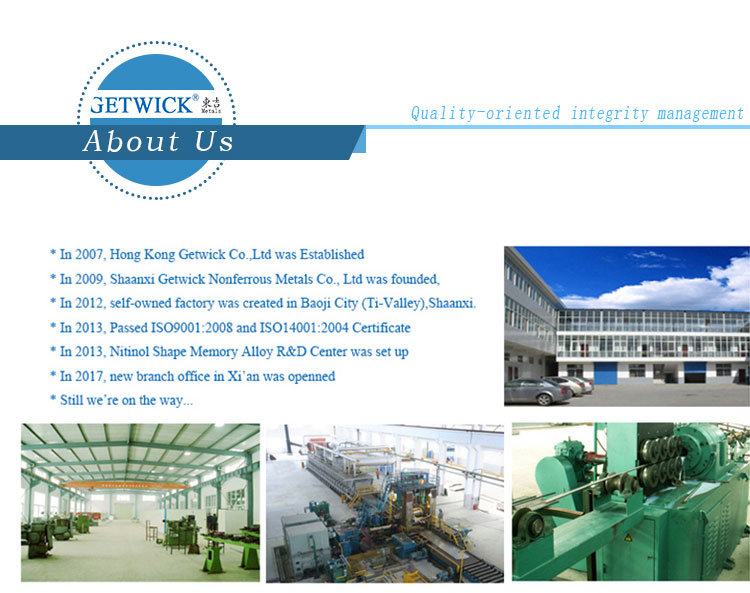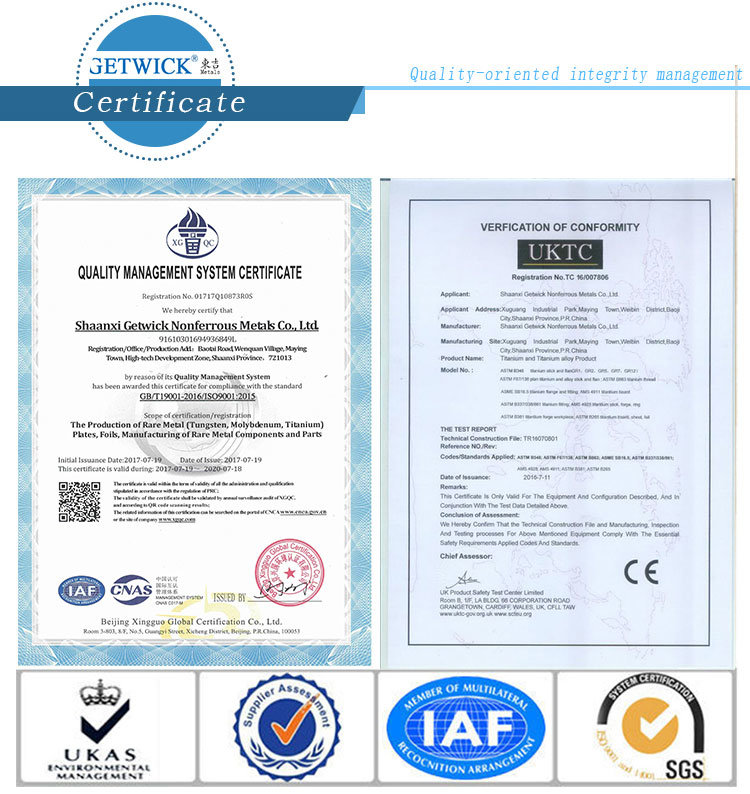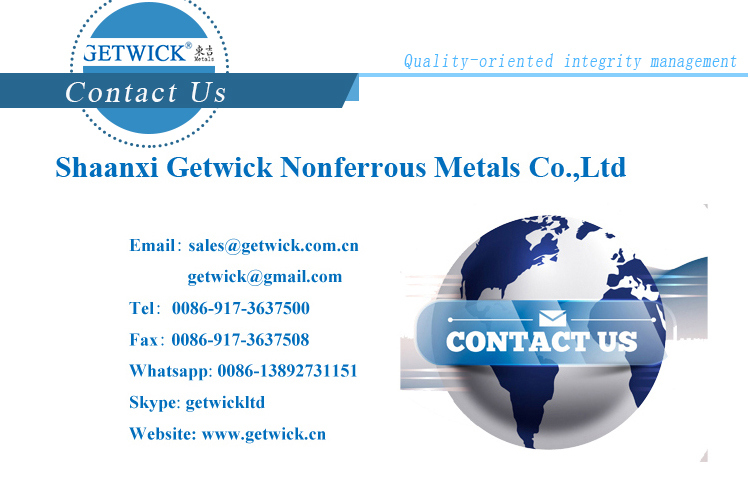
Product: W-Cu alloy tube
Grade:W90Cu10,W80Cu20,W75Cu25,W70Cu30,W60Cu40,W50Cu50
Shape:tube,pipe
Size:As per request.Â
Material Introduction for tungsten copperÂ
Tungsten copper alloy is the composite of Tungsten and Copper, which own the excellent performances of Tungsten and Copper, such as heat-resistant, ablate-resistant, high-intensity, excellent thermal and electrical conductivity. Tungsten copper alloy is easy to be machined. Tungsten copper alloy is used widely in such industries as engine, electrical power, electron, metallurgy, spaceflight and aviation. Using CIP formation, sintered tungsten skeleton and infiltrating copper (silver) technology, large size and special shape products of WCu composites with 6-90 percent of copper are produced, such as electric contacts, electrode, refractory parts, heat sinks and parts of rocket, We can also produce Tungsten copper alloy sheet material, tubing, plate and other small products by mould pressing, extrusion pressing and MIM.
Application of tungsten copper
Tungsten copper Alloy (W-Cu alloy) is the composite of tungsten and copper which own it excellent performance of tungsten and copper. It is used widely in such industries as engine, electric power, electron, metallurgy, spaceflight and aviation.
1,High Performance Material for Aerospace Industry
2,Vacuum contact materials
3,Electrodes for electrical discharge machining
4,Electronic packaging materials and heat sink material
Application:
WCu composite materials since the 20th century, 30 years since the advent of a long period of time is mainly used for various types of high voltage electrical switch electrical contact. It is because of the high WCu composite ablative properties of compressive strength and electrical resistance, so that the pressure level of high-voltage electrical switches and the use of power continue to improve and become a high-voltage electrical switches in the indispensable key material. To 60 years, WCu material as resistance welding and EDM electrodes and space technology in high-temperature materials exposed to high temperature gas phase are applied. But until the 80's, with the WCu materials, production process improvements and improving the quality of WCu composite material that is to obtain more extensive and sophisticated applications. 90 20th century, with the large scale integrated circuit and the development of high-power electronic devices, WCu material as the upgrading of the products began to do large-scale use of electronic packaging and heat sink material.
Specifications of tungsten copper alloy
| Specifications of WCu  Alloy Tube: | ||||||||
| Code No. | Chemical Composition % | Mechanical properties | ||||||
| CU | Impurity | W | Density(g/cm 3 ) | Hardness HBÂ |
RES( cm) | Conductivity IACS/ % |
TRS/ Mpa | |
| CuW(50) | 50 + 2.0 | 0.5 | Balance | 11.85 | 115 | 3.2 | 54 | Â |
| CuW(55) | 45 + | 0.5 | Balance | 12.3 | 125 | 3.5 | 49 | Â |
| 2 | ||||||||
| CuW(60) | 40 + 2.0 | 0.5 | Balance | 12.75 | 140 | 3.7 | 47 | Â |
| CuW(65) | 35 + 2.0 | 0.5 | Balance | 13.3 | 155 | 3.9 | 44 | Â |
| CuW(70) | 30 + 2.0 | 0.5 | Balance | 13.8 | 175 | 4.1 | 42 | 790 |
| CuW(75) | 25 + 2.0 | 0.5 | Balance | 14.5 | 195 | 4.5 | 38 | 885 |
| CuW(80) | 20 + 2.0 | 0.5 | Balance | 15.15 | 220 | 5 | 34 | 980 |
| CuW(85) | 15 + 2.0 | 0.5 | Balance | 15.9 | 240 | 5.7 | 30 | 1080 |
| CuW(90) | 10 + 2.0 | 0.5 | Balance | 16.75 | 260 | 6.5 | 27 | 1160 |





Â
Niobium Metals, plate, bar, wire, tube, target
Purity 99.95% min.
Density 8.6 g/cc
SGS certificate
Niobium belongs to the group of refractory metals. Refractory metals are metals that have a higher melting point than platinum (1 772 °C). In refractory metals, the energy binding the individual atoms together is particularly high. Refractory metals have a high melting pointcoupled with a low vapor pressure, high modulus of elasticity and high thermal stability. Refractory metals are also characterized by a low coefficient of thermal expansion. Compared to other refractory metals, niobium has a relatively low density of only 8.6 g/cm3
Niobium is located in the same period as Molybdenum in the periodic table. Its density and melting point are therefore comparable to those of molybdenum. In the same way as Tantalum , niobium is prone to hydrogen embrittlement. The heat treatment of niobium therefore takes place in a high vacuum and not in a hydrogen atmosphere. Both niobium and tantalum also offer a high level of resistance against all acids and good formability.
At -263.95 °C, niobium has the highest transition temperature of all elements. Below this temperature, niobium is superconducting. And what is more, niobium boasts a very special range of properties:
|
Properties |
||
|
Atomic number |
41 |
|
|
Atomic mass |
92.91 |
|
|
Melting point |
2 468 °C / 2 741 K |
|
|
Boiling point |
4 900 °C / 5 173 K |
|
|
Atomic volume |
1.80 · 10-29 [m3] |
|
|
Vapor pressure |
at 1 800 °C |
5 · 10-6 [Pa] |
|
at 2 200 °C |
4 · 10-3 [Pa] |
|
|
Density at 20 °C |
8.55 [g/cm3] |
|
|
Crystal structure |
body-centered cubic |
|
|
Lattice constant |
329.4 · 10-12 [m] |
|
|
Hardness at 20 °C |
formed |
110 - 180 [HV10] |
|
recrystallized |
60 - 110 [HV10] |
|
|
Modulus of elasticity at 20 °C |
104 [GPa] |
|
|
Poisson number |
0.35 |
|
|
Coefficient of linear thermal expansion at 20 °C |
7.1 · 10-6 [m/(m·K)] |
|
|
Thermal conductivity at 20 °C |
52 [W/(m·K)] |
|
|
Specific heat at 20 °C |
0.27 [J/(g·K)] |
|
|
Electrical conductivity at 20 °C |
7 · 10-6 [1/(Ω·m)] |
|
|
Specific electrical resistance at 20 °C |
0.14 [(Ω·mm2)/m] |
|
|
Sound speed at 20 °C |
Longitudinal wave |
4 920 [m/s] |
|
Transverse wave |
2 100 [m/s] |
|
|
Electron work function |
4.36 [eV] |
|
|
Capture cross-section for thermal neutrons |
1.15 · 10-28 [m2] |
|
|
Recrystallization temperature (annealing time:1 hour) |
850 - 1 300 [ °C] |
|
|
Superconductivity (transition temperature) |
< -263.95 °C / < 9.2 K |
|
Niobium Bar,High Purity Niobium Bar,Pure Niobium Round Bars,Pure Niobium Bars 99.95%
Baoji Shengyuan Metal Material Co., Ltd. , http://www.baojisymetal.com